

Talking about the Priorat is talking about wine. Since the end of the Eighties, Priorat has become famous for its wines all over the world. Prestigious producers like Carles Pastrana (Clos de l'Obac, Miserere, Dolç de l'Obac), Alvaro Palacios (L'Ermita, Finca Dofí, Les Terrasses), Dafné Glorian (Clos Erasmus), José-Luis Pérez (Clos Martinet, Cims de Porrera) or René Barbier (Clos Mogador) have established their cellar there.
|
Sol de licorella |
|
From a geological point of view Priorat is quite a singularity. The ground is made of licorella, a very friable, loose and soft slate. This earth stores humidity, hence featuring an optimal soil for the vines. In addition, the slate stores the heat radiated by the sun besides reflecting its light. From a climatological point of view, the Priorat is protected on the North side by the Sierra del Montsant. The combination of these factors build up the ideal conditions for vine growing. |
|
Vine growing in Priorat starts around the second half of the 12th century, as Carthusian Monks settled down in Scala Dei. Rapidly the region gets well known for good wines. In 1800, the total cultivated surfaces are close to 6'000 hectares. Unfortunately, around 1900, the phylloxera will wipe out all of the Priorat vineyards. The phylloxera is a microscopic greenfly that came to Europe on vine plants imported from america at the end of 19th century. This parasite takes on the plant's roots, eventually killing it. The phylloxera is still present in the soil today. This is the reason why all vines are grafted on American plants which are resistant to it. Further to this disaster, the cultivated surfaces in 1950/60 amount to only 300 hectares (there were 6000 in 1800). Under Franco's dictature, the Priorat is left abandoned, one of the poorest regions of Spain. |

Le hameau de Scala Dei, adossé au Montsant |
The New Pioneers
At the end of the seventies, René Barbier, accompanied by Carles Pastrana and José-Luis Peréz (they were joined later by Dafné Glorian, Adrian Garsed, Luc van Iseghem (†) and Alvaro Palacios), convinced that the region offers the best conditions for making good wines, give the adventure a try. The original concept is tinged with some idealism: to restore the wine tradition, true to the 12th century Carthusians spirit, by reviving and rebuilding the abandoned terraces. They buy land, replant vines, round off the local traditional grapes (Garnatxa, Cariñena, tempranillo) with Cabernet or Syrah. Of course they use the newest oenological knowledge and technologies. The first vintage (1989) of these New Priorat is produced in common facilities, but bottled under different appellations: Clos Mogador, Clos de l'Obac, Clos Martinet, Clos Garsed, Clos dels Llops (a 1989 vintage of these last two is practically unobtainable today). Despite the fact that they hadn't been granted the DOC Priorat at this time (!), the success is immediate. However the business reality took over, and our friends soon drove apart, leading each their own enterprise.
So what shall we drink now ?
Since a few years the region is expanding rapidly. This is as good as bad. Quite a few newcomers give it a try with more or less success. You may find great things, but also be disappointed. If you prefer blue chips to speculative values, here are some recommendations. The list below not only includes wines from the DOCa Priorat, but also from the adjacent zones DO Tarragona and DO Montsant.
These are all wines of high quality, produced with great care. We tasted them personally, and found them good. However, how much you like a wine is always a subjective matter, so we decided finally to order them according to the price.
|
|
Clos dels Llops 1989 - a piece of history, practically unobtainable today. Notice the absence of the DOC PRIORAT on the label.
L'Ermita vineyard (Alvaro Palacios) |
© Copyright Notice - Last Updated: 19.10.2009